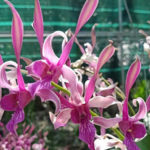In addition to popular flowers used for Tết (Lunar New Year) decoration such as apricot blossom, lilies, and lilies, dendrobium orchids are also a wonderful choice to bring a year full of luck and happiness. Today, let’s learn more about how to grow dendrobium orchids, their meaning, and some interesting facts about them.
1. Introduction to Dendrobium Orchids
Dendrobium orchids, or Cymbidium Sinense in scientific terms, belong to the orchid family. They are also known as the rarest of three types of plants, including dai hoang, hoang diem, and hoang vu.
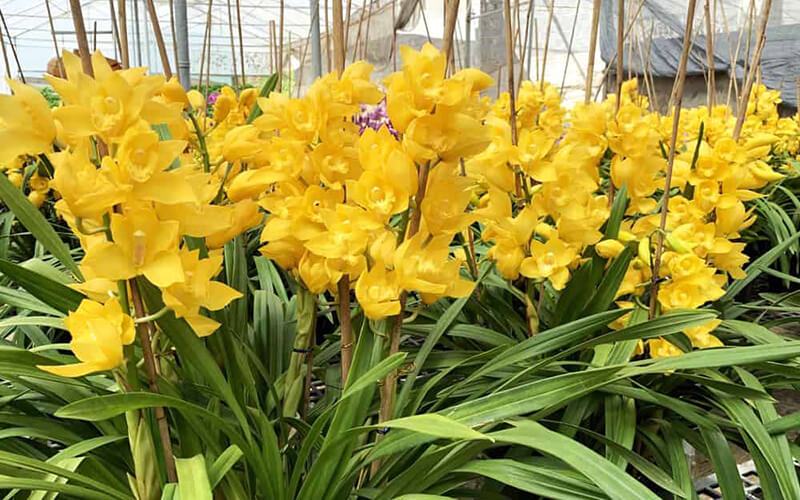 Dendrobium orchids originate from southwestern China
Dendrobium orchids originate from southwestern China
The original source of dendrobium orchids is southwestern China, and later they were introduced to tropical and subtropical regions. In Vietnam, the province of Nam Dinh is the first place where hoang vu dendrobium orchids appeared.
In terms of characteristics, dendrobium orchids are perennial herbs with an average height of 0.5–1.5 meters. Their roots are soft, large, and plump, with a cylindrical shape, mostly light gray in color, and they grow very vigorously, sometimes with branching.
Dendrobium orchids have short, swollen stems with shapes like rounded eggs, ovals, hemispheres, egg-shaped, or stick-like, and they are also called pseudobulbs, which store water and nutrients to nourish the plant.
 Dendrobium orchid leaves are long and pointed
Dendrobium orchid leaves are long and pointed
Dendrobium orchid leaves are long and pointed, with the base clasping each other, a flat margin, with veins and no teeth, and they usually grow in clumps, with 6–10 single leaves overlapping. Dendrobium orchid leaves grow from the stem and branch out from the ground, with varying lengths and thicknesses depending on the species.
Dendrobium orchids have a peduncle that grows from the pseudobulb, with about 10–12 single flowers on each peduncle. All dendrobium orchid flowers have a butterfly-like shape, a simple structure consisting of 3 sepals, 3 petals, and 1 pistil, with the sepals resembling petals.
Dendrobium orchids come in a variety of vibrant colors such as red, white, yellow, purple, and so on, and they are smaller in size compared to other orchid species. The dendrobium orchid inflorescence can be twice as tall as the stem, and the number of flowers per inflorescence, as well as their shape, color, fragrance, and duration, vary among different types of dendrobium orchids.
 Dendrobium orchid fruits are a type of capsule with an elongated shape
Dendrobium orchid fruits are a type of capsule with an elongated shape
Dendrobium orchid fruits are a type of capsule, and their size depends on the parent species, typically elongated and about 10–20 cm long. When the fruit ripens, it splits open and the seeds are dispersed.
Dendrobium orchid seeds are very small, about 0.5 mm in size, very light, and numerous. The seeds have an oval shape with a small embryo in the center, surrounded by a thin, transparent layer of cells with circular stripes that increase the seed’s thickness.
Dendrobium orchids have good pest resistance and grow and develop quite quickly. Late spring, around February to March, is usually when dendrobium orchids bloom profusely, and the flowers can last for about 1–2 months.
2. Types of Dendrobium Orchids and Their Characteristics
There are about 48 different types of dendrobium orchids, classified according to various criteria. The most common ones are red, white, yellow, and purple dendrobium orchids.
Red Dendrobium Orchids
 Red Dendrobium Orchids
Red Dendrobium Orchids
Red dendrobium orchids are currently very rare and need serious protection. They are favored by many countries because their red color symbolizes strength and brings good luck, and they are also a symbol of elegance. In addition, they can help balance the climate and reduce negative external influences.
White Dendrobium Orchids
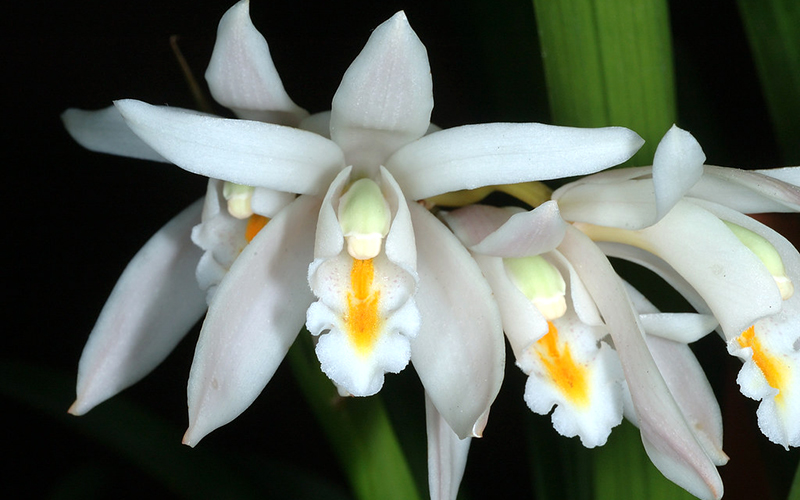 White Dendrobium Orchids
White Dendrobium Orchids
During Tết, white dendrobium orchids symbolize good luck, wealth, and health for everyone. In particular, they also represent the image of a virgin girl, pure, and lovely, in her youthful prime and full of vitality.
Yellow Dendrobium Orchids
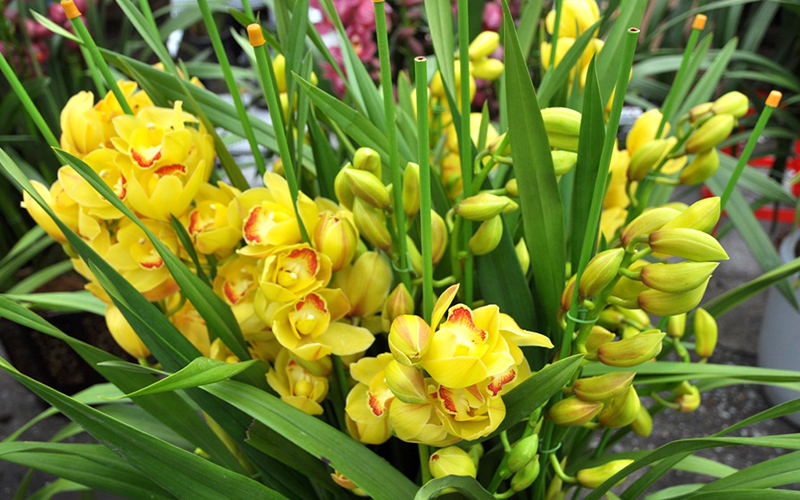 Yellow Dendrobium Orchids
Yellow Dendrobium Orchids
This is an easy-to-graft variety, with bright yellow as the main color and stripes or spots of orange, red, copper, brown, white, and so on in the center. The flowers usually bloom for about 8–10 weeks and only bloom once a year. The beauty of yellow dendrobium orchids lies in their elegance, bringing good luck, wealth, prosperity, and joy to the owner.
Purple Dendrobium Orchids
 Purple Dendrobium Orchids
Purple Dendrobium Orchids
This is a type of cattleya orchid with a deep purple color, and it is also an easy-to-grow variety. You can place them under a canopy net or under a tree and water them about 1–3 times a day to ensure regular flowering. Purple dendrobium orchids symbolize elegance and luxury, and when they bloom, it signifies that the owner will soon encounter good luck.
3. Meaning of Dendrobium Orchids
Dendrobium orchids are known as the “king of flowers” or the “flower of the mountains” due to their graceful and captivating beauty. They represent elegance, luxury, and refinement, thanks to their diverse varieties and colors.
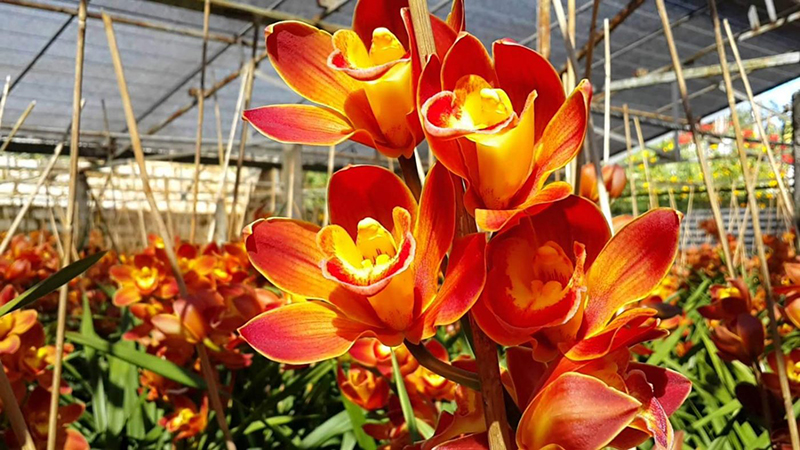 Dendrobium orchids exude elegance and bring positive meanings
Dendrobium orchids exude elegance and bring positive meanings
In addition, dendrobium orchids have become increasingly popular during Tết in recent years, as people hope for a new year filled with luck and happiness, as the flowers symbolize good fortune, prosperity, and health, especially during the festive season.
4. Uses of Dendrobium Orchids
Blooming during Tết, the vibrant and colorful dendrobium orchids are often purchased to decorate homes, wishing for a new year filled with luck and happiness, just like the flowers themselves.
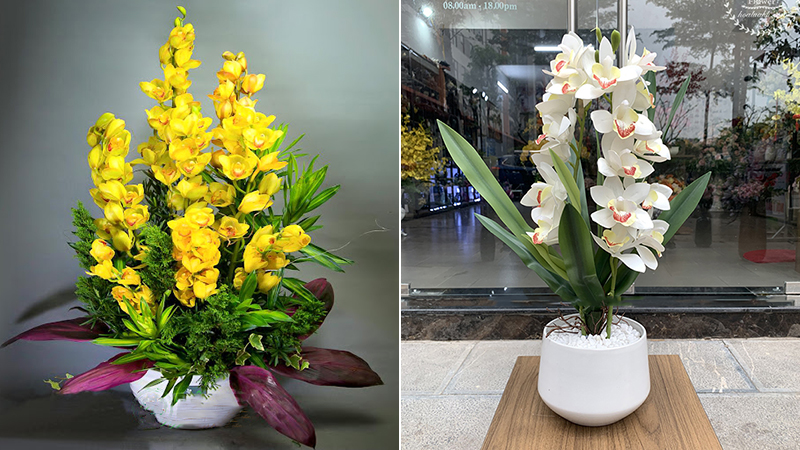 Dendrobium orchids are a suitable gift for friends, family, and colleagues
Dendrobium orchids are a suitable gift for friends, family, and colleagues
In addition, dendrobium orchids are a great gift choice for loved ones, friends, and colleagues on occasions such as birthdays, housewarmings, or other holidays. Furthermore, dendrobium orchids are also in high demand for the production of cosmetics and perfumes for women’s beauty needs, so they are not inexpensive.
Moreover, according to folklore, dendrobium orchids, like other green plants, have the ability to photosynthesize, absorb toxic gases, and release oxygen necessary for humans. The fragrance of dendrobium orchids can also help relieve fatigue, headaches, and stress.
5. How to Grow and Care for Dendrobium Orchids
Growing Dendrobium Orchids
Choosing Soil for Dendrobium Orchids
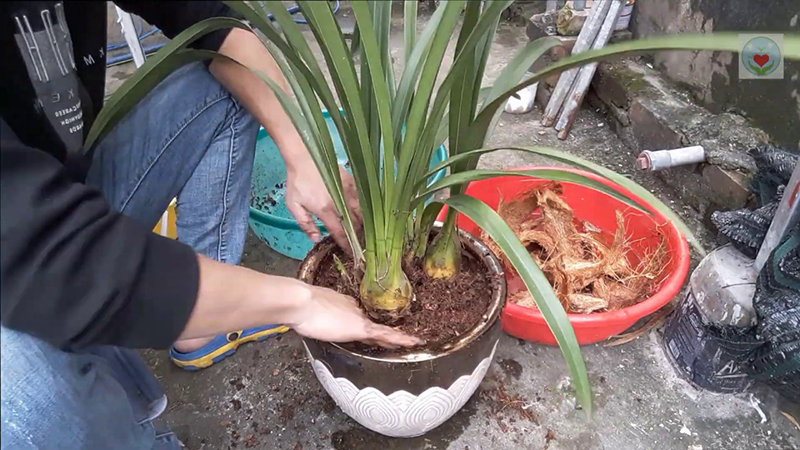 Soil for dendrobium orchids should have a high humus and silt content and a certain level of moisture
Soil for dendrobium orchids should have a high humus and silt content and a certain level of moisture
When growing dendrobium orchids, it is recommended to choose soil with a high humus and silt content, a certain level of moisture, and a pH level that is not too high, as it can negatively affect the plant’s growth.
Alternatively, you can use dried pond mud, crushed to a size of 1–1.5 cm, and mix it with other materials in the following ratio: 3 parts soil/pond mud, 3 parts compost, 2 parts processed coconut fiber, 1 part rice husk, 0.5 parts earthworm castings, and 0.5 parts lime powder. Then, let it sit in a cool place for 10–15 days and air-dry for a week to kill any pathogens.
Choosing a Pot for Dendrobium Orchids
 Choose a pot that is suitable for the size of your dendrobium orchid
Choose a pot that is suitable for the size of your dendrobium orchid
It is important to select a pot that matches the size of your dendrobium orchid, avoiding pots that are too small or too large. For the best growth and minimal pests, use pots made of clay or coconut shells.
For new pots, rinse them with water, and for used pots, clean them with a damp cloth and a diluted disinfectant solution, then air-dry the pots thoroughly before planting.
Dendrobium Orchid Planting Technique
 How to plant dendrobium orchids
How to plant dendrobium orchids
First, fill the pot with soil to about one-third, then place the dendrobium orchid in it. Note to position the older stem towards the center and the younger stem towards the mouth of the pot for a balanced appearance. Next, use one hand to hold the orchid in place while using the other hand to fill the pot with soil until it is nearly full. Finally, gently press the base of the plant with your hand to secure it.
You can also cover the surface of the pot with a layer of rice husks, moss, or cinder crumbs. Then, use a hose to water the pot and a spray bottle to gently clean the leaves during the planting process. Lastly, place the potted orchid in a high, cool, and shaded area, avoiding direct sunlight.
Caring for Dendrobium Orchids
Watering Dendrobium Orchids
First and foremost, avoid excessive moisture or dryness, as it can lead to the death of the plant. Maintain a moisture level of 70–85% for dendrobium orchids. The amount of water needed depends on the size of the pot and the plant.
 Pay attention to the moisture level of dendrobium orchids, keeping it between 70–85%
Pay attention to the moisture level of dendrobium orchids, keeping it between 70–85%
It is important to provide water to the plant according to its developmental stage, such as when it is in bloom. Dendrobium orchids require a moderate amount of water, and overwatering can lead to increased metabolic activity, the development of fungal diseases, shortened blooming period, and reduced flower quality.
On the other hand, insufficient water can cause bud and flower drop and shorten the flowering period. Observe the moisture level of the soil and water once or twice a day if the soil is still damp, or adjust the amount of water accordingly if the soil is drier.
Fertilizing Dendrobium Orchids


